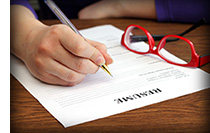Developing Your Resume/Cover Letter

Keys to an Effective Resume
Your resume is a marketing tool which should be written to interest an employer enough to bring you in for an interview. While there is no one right way to write a resume or cover letter, there are some ways to make them more effective and more likely to get you an interview.
The two most important things to keep in mind when writing a resume are: “Who is the audience for my resume and what do they need to know about me?”
- Your audience is: Human Resources, Recruiters and/or Hiring Managers.
- What they need to know: You have the most current and relevant qualifications for their specific job opening.
Targeted
Your resume should clearly show that you possess the skills, education or training and experience that the employer is seeking for the specific job opening they have. The employer has spelled out what they need in the job posting and your resume should show that you have most (if not all) of what they want.
You must target your resume to a specific job opening to have the best chance for success.
Keywords
Keywords are the most important words in the job posting and are often repeated. Keywords can include:
- Type of degree/certification/training
- Skills
- Technical expertise
- Specific work experience
- Personal/professional qualities
You want to make sure the keywords from the job posting are in your resume. Employers will be using keywords to screen resumes for a good match with their open position. Check here for more information on the importance of using keywords.
Accomplishments/Results
For each job you’ve had, you will want to include several bullet points that describe tasks or responsibilities you had. These will appear in the Professional (or Work) Experience section of your resume.

However, it’s not enough to list tasks, you also want to include accomplishments and results you achieved as an employee. It’s best to include results that can be quantified in some way, such as using dollar amounts, percentages or other numbers.
See the sample resumes below for ideas on quantifiable results:
- Sample Student Resume
- Sample Community Member Resume
- Sample Career Change Resume
- Sample Student Workforce Program Resume
It’s best to focus on responsibilities and results that are directly relevant to your next employer and their specific job. All bullet points in this section should start with an action verb.
You can also use the PAR Technique for describing your results.
P – What Problem or situation were you faced with on the job?
A – What Action(s) did you take to handle the problem?
R – What was the positive Result of the action you took?
Visually Appealing
Your resume should be organized and easy to read. See these Resume Guidelines for more ways to improve your resume.
Clearly Defined Sections
Common resume sections include:
Contact Information
- Full name
- Phone number
- Email address
- Home address (optional)
- LinkedIn URL (optional)
Summary
Two to four sentences introducing yourself and what you have to offer the employer. This section is meant to interest the employer in reading the rest of your resume.
Skills
Bulleted section that should include the specific skills that the employer is seeking.
Professional (or Work) Experience
For each job you’ve had, include 3-6 bullet points, starting with an action verb that describe what you did in that job. List your jobs in reverse chronological order (current or most recent job first and then go backward in time).
Education
Include any degrees, certifications or trainings you have completed or that are in progress. List these in reverse chronological order. See the sample resumes above for formatting ideas.
Other optional sections include: Professional Organizations, Awards, Volunteer Service and others.
Do not include a section on References, which should be on a separate page from the resume.
See Resume Guidelines for more things to avoid. Check here for more helpful information on resumes.
Cover Letters
You should include a cover letter with your resume and job application. It gives you a chance to express what you know about the company and why you want to work there.
Like resumes, cover letters should be tailored to the specific employer and job opportunity. See Cover Letters for sample formats.

